Impacts of Tree Canopy Cover on Microclimate and Human Thermal Comfort in a Shallow Street Canyon in Wuhan, China
Abstract
1. Introduction
2. Materials and Methods
2.1. Study Area and Sampling Sites
2.2. Micrometeorological Measurements
2.3. Questionnaire Survey
3. Results and Discussion
3.1. Impact of Street Tree Canopy Cover on Microclimate Factors
3.1.1. Air Temperature (Ta)
3.1.2. Relative Humidity (RH)
3.1.3. Wind Speed (WS)
3.1.4. Mean Radiant Temperature (Tmrt)
3.2. Impact of Street Tree Canopy Cover on Human Thermal Comfort
3.2.1. Thermal Sensation Vote (TSV) under Different Degrees of Tree Canopy Cover
3.2.2. Neutral PET
3.3. Predictive Formula for Thermal Sensation
3.4. Limitations and Recommendations for Future Studies
4. Conclusions
- In the hot and humid climate of Wuhan, the microclimate benefits of a high-percentage tree canopy cover are greater than that from medium- and low-percentage tree canopy cover, particularly at noon. High-percentage tree canopy cover over a street can reduce midday (12:00–14:00) air temperature and mean radiant temperature by up to 3.3 °C and 13.9 °C, respectively, compared with a similar street lacking tree shade;
- Human thermal sensations are affected by a combination of psychology and physiology. Psychological adaptations can help people cope better with their current thermal environment. Thermal sensations are related to the extent of street greenery; the higher the tree canopy cover, the easier it is for people to feel satisfied with their current thermal environment;
- The neutral and moderate PET thermal ranges that represented the comfort of people on the streets in Wuhan in summer were found to be 28.8 °C and 26.35–31.29 °C, respectively.
- The thermal sensation prediction formula is proposed and the relationship between human thermal sensation and microclimate factors is established. It is found that blocking solar radiation and increasing wind speed are more feasible than controlling air temperature and humidity as ways to improve human thermal comfort.
Author Contributions
Funding
Acknowledgments
Conflicts of Interest
References
- Lee, H.; Holst, J.; Mayer, H. Modification of human-biometeorologically significant radiant flux densities by shading as local method to mitigate heat stress in summer within urban street canyons. Adv. Meteorol. 2013, 2013, 1–13. [Google Scholar] [CrossRef]
- Piselli, C.; Castaldo, V.; Pigliautile, I.; Pisello, A.; Cotana, F. Outdoor comfort conditions in urban areas: On citizens’ perspective about microclimate mitigation of urban transit areas. Sustain. Cities Soc. 2018, 39, 16–36. [Google Scholar] [CrossRef]
- Knez, I.; Thorsson, S. Influences of culture and environmental attitude on thermal, emotional and perceptual evaluations of a public square. Int. J. Biometeorol. 2006, 50, 258–268. [Google Scholar] [CrossRef] [PubMed]
- Armson, D.; Rahman, M.A.; Ennos, A.R. A comparison of the shading effectiveness of five different street tree species in Manchester, UK. Arboric. Urban For. 2013, 39, 157–164. [Google Scholar]
- Coutts, A.M.; White, E.C.; Tapper, N.J.; Beringer, J.; Livesley, S.J. Temperature and human thermal comfort effects of street trees across three contrasting street canyon environments. Theor. Appl. Climatol. 2016, 124, 55–68. [Google Scholar] [CrossRef]
- Kong, L.; Lau, K.K.-L.; Yuan, C.; Chen, Y.; Xu, Y.; Ren, C.; Ng, E. Regulation of outdoor thermal comfort by trees in Hong Kong. Sustain. Cities Soc. 2017, 31, 12–25. [Google Scholar] [CrossRef]
- Lee, H.; Mayer, H.; Chen, L. Contribution of trees and grasslands to the mitigation of human heat stress in a residential district of Freiburg, Southwest Germany. Landsc. Urban Plan. 2016, 148, 37–50. [Google Scholar] [CrossRef]
- Morakinyo, T.E.; Lau, K.K.-L.; Ren, C.; Ng, E. Performance of Hong Kong’s common trees species for outdoor temperature regulation, thermal comfort and energy saving. Build. Environ. 2018, 137, 157–170. [Google Scholar] [CrossRef]
- Santos Nouri, A.; Fröhlich, D.; Matos Silva, M.; Matzarakis, A. The impact of Tipuana tipu species on local human thermal comfort thresholds in different urban canyon cases in Mediterranean climates: Lisbon, Portugal. Atmosphere 2018, 9, 12. [Google Scholar] [CrossRef]
- Höppe, P. The physiological equivalent temperature—A universal index for the biometeorological assessment of the thermal environment. Int. J. Biometeorol. 1999, 43, 71–75. [Google Scholar] [CrossRef]
- Matzarakis, A.; Mayer, H.; Iziomon, M.G. Applications of a universal thermal index: Physiological equivalent temperature. Int. J. Biometeorol. 1999, 43, 76–84. [Google Scholar] [CrossRef] [PubMed]
- Shashua-Bar, L.; Potchter, O.; Bitan, A.; Boltansky, D.; Yaakov, Y. Microclimate modelling of street tree species effects within the varied urban morphology in the Mediterranean city of Tel Aviv, Israel. Int. J. Climatol. 2010, 30, 44–57. [Google Scholar] [CrossRef]
- Klemm, W.; Heusinkveld, B.G.; Lenzholzer, S.; Jacobs, M.H.; Van Hove, B. Psychological and physical impact of urban green spaces on outdoor thermal comfort during summertime in The Netherlands. Build. Environ. 2015, 83, 120–128. [Google Scholar] [CrossRef]
- Klemm, W.; Heusinkveld, B.G.; Lenzholzer, S.; van Hove, B. Street greenery and its physical and psychological impact on thermal comfort. Landsc. Urban Plan. 2015, 138, 87–98. [Google Scholar] [CrossRef]
- Elnabawi, M.H.; Hamza, N. Behavioural Perspectives of Outdoor Thermal Comfort in Urban Areas: A Critical Review. Atmosphere 2019, 11, 51. [Google Scholar] [CrossRef]
- Amindeldar, S.; Heidari, S.; Khalili, M. The effect of personal and microclimatic variables on outdoor thermal comfort: A field study in Tehran in cold season. Sustain. Cities Soc. 2017, 32, 153–159. [Google Scholar] [CrossRef]
- Krüger, E.L.; Rossi, F.A. Effect of personal and microclimatic variables on observed thermal sensation from a field study in southern Brazil. Build. Environ. 2011, 46, 690–697. [Google Scholar] [CrossRef]
- Fang, Z.; Lin, Z.; Mak, C.M.; Niu, J.; Tse, K.-T. Investigation into sensitivities of factors in outdoor thermal comfort indices. Build. Environ. 2018, 128, 129–142. [Google Scholar] [CrossRef]
- Lenzholzer, S.; Koh, J. Immersed in microclimatic space: Microclimate experience and perception of spatial configurations in Dutch squares. Landsc. Urban Plan. 2010, 95, 1–15. [Google Scholar] [CrossRef]
- Nikolopoulou, M.; Steemers, K. Thermal comfort and psychological adaptation as a guide for designing urban spaces. Energy Build. 2003, 35, 95–101. [Google Scholar] [CrossRef]
- Jin, H.; Liu, S.; Kang, J. Thermal comfort range and influence factor of urban pedestrian streets in severe cold regions. Energy Build. 2019, 198, 197–206. [Google Scholar] [CrossRef]
- Li, K.; Zhang, Y.; Zhao, L. Outdoor thermal comfort and activities in the urban residential community in a humid subtropical area of China. Energy Build. 2016, 133, 498–511. [Google Scholar] [CrossRef]
- Nikolopoulou, M.; Lykoudis, S. Thermal comfort in outdoor urban spaces: Analysis across different European countries. Build. Environ. 2006, 41, 1455–1470. [Google Scholar] [CrossRef]
- Gobo, J.P.A.; Faria, M.R.; Galvani, E.; Goncalves, F.L.T.; Monteiro, L.M. Empirical Model of Human Thermal Comfort in Subtropical Climates: A First Approach to the Brazilian Subtropical Index (BSI). Atmosphere 2018, 9, 391. [Google Scholar] [CrossRef]
- Gravetter, F.J.; Wallnau, L.B. Essentials of Statistics for the Behavioral Sciences; Wadsworth: Belmont, TN, USA, 2008. [Google Scholar]
- Cheng, V.; Ng, E.; Chan, C.; Givoni, B. Outdoor thermal comfort study in a sub-tropical climate: A longitudinal study based in Hong Kong. Int. J. Biometeorol. 2012, 56, 43–56. [Google Scholar] [CrossRef] [PubMed]
- Givoni, B.; Noguchi, M.; Saaroni, H.; Pochter, O.; Yaacov, Y.; Feller, N.; Becker, S. Outdoor comfort research issues. Energy Build. 2003, 35, 77–86. [Google Scholar] [CrossRef]
- Uchida, M.; Mochida, A.; Sasaki, K.; Tonouchi, T. Field measurements on turbulent flow field and thermal environment in and around biotope with pond and green space. In Proceedings of the Seventh International Conference on Urban Climate, Yokohama, Japan, 29 June–3 July 2009. [Google Scholar]
- Zhenghong, C.; Haijun, W.; Guoyu, R. Asymmetrical Change of Urban Heat Island Intensity in Wuhan, China. Adv. Clim. Chang. Res. 2007, 9, 282–286. [Google Scholar]
- The Second C40 Urban Sustainable Development Forum Held in Wuhan. Available online: http://www.hubei.gov.cn/xxbs/bmbs/sfgw1/201709/t20170925_1067458.shtml (accessed on 17 March 2020).
- Yu, J.; Yang, C.; Tian, L. Low-energy envelope design of residential building in hot summer and cold winter zone in China. Energy Build. 2008, 40, 1536–1546. [Google Scholar] [CrossRef]
- Zhang, L.; Zhan, Q.; Lan, Y. Effects of the tree distribution and species on outdoor environment conditions in a hot summer and cold winter zone: A case study in Wuhan residential quarters. Build. Environ. 2018, 130, 27–39. [Google Scholar] [CrossRef]
- Thorsson, S.; Lindberg, F.; Eliasson, I.; Holmer, B. Different methods for estimating the mean radiant temperature in an outdoor urban setting. Int. J. Climatol. 2007, 27, 1983–1993. [Google Scholar] [CrossRef]
- Souch, C. The effect of trees on summertime below canopy urban climates: A case study Bloomington, Indiana. J. Arboric. 1993, 19, 303–312. [Google Scholar]
- Vailshery, L.S.; Jaganmohan, M.; Nagendra, H. Effect of street trees on microclimate and air pollution in a tropical city. Urban For. Urban Green. 2013, 12, 408–415. [Google Scholar] [CrossRef]
- Shashua-Bar, L.; Hoffman, M.E. Vegetation as a climatic component in the design of an urban street: An empirical model for predicting the cooling effect of urban green areas with trees. Energy Build. 2000, 31, 221–235. [Google Scholar] [CrossRef]
- Sanusi, R.; Johnstone, D.; May, P.; Livesley, S.J. Street orientation and side of the street greatly influence the microclimatic benefits street trees can provide in summer. J. Environ. Qual. 2016, 45, 167–174. [Google Scholar] [CrossRef] [PubMed]
- McNall, P.; Jaax, J.; Rohles, F.; Nevins, R.; Springer, W. Thermal comfort (thermally neutral) conditions for three levels of activity. ASHRAE Trans. 1967, 73, 1–3. [Google Scholar]
- Park, M.; Hagishima, A.; Tanimoto, J.; Narita, K.-I. Effect of urban vegetation on outdoor thermal environment: Field measurement at a scale model site. Build. Environ. 2012, 56, 38–46. [Google Scholar] [CrossRef]
- Djamila, H.; Kumaresan, S.; Chu, C.-M. Standard 55-2004: Thermal Environment Conditions for Human Occupancy; American Society of Heating, Ventilating and Air-Conditioning Engineers, Inc.: Atlanta, GA, USA, 2004. [Google Scholar]
- Ng, E.; Yau, R.; Wong, K.; Ren, C.; Katszchner, L. Final Report of Hong Kong Urban Climatic Map and Standards for Wind Environment—Feasibility Study; Planning Department of Hong Kong Government: Hongkong, China, 2012.
- Williams, R. Field investigation of thermal comfort, environmental satisfaction and perceived control levels in UK office buildings. In Proceedings of the 4th International Conference Healthy Buildings, Milan, Italy, 10–14 September 1995; pp. 1181–1186. [Google Scholar]
- McIntyre, D.A. Indoor Climate; Applied Science: Essex, UK, 1980. [Google Scholar]
- Shooshtarian, S. Theoretical dimension of outdoor thermal comfort research. Sustain. Cities Soc. 2019, 47, 101495. [Google Scholar] [CrossRef]
- Kántor, N.; Unger, J.; Gulyás, Á. Subjective estimations of thermal environment in recreational urban spaces—Part 2: International comparison. Int. J. Biometeorol. 2012, 56, 1089–1101. [Google Scholar] [CrossRef]
- Thorsson, S.; Honjo, T.; Lindberg, F.; Eliasson, I.; Lim, E.-M. Thermal comfort and outdoor activity in Japanese urban public places. Environ. Behav. 2007, 39, 660–684. [Google Scholar] [CrossRef]
- Yin, J.; Zheng, Y.; Wu, R.; Tan, J.; Ye, D.; Wang, W. An analysis of influential factors on outdoor thermal comfort in summer. Int. J. Biometeorol. 2012, 56, 941–948. [Google Scholar] [CrossRef]
- Yang, W.; Wong, N.H.; Zhang, G. A comparative analysis of human thermal conditions in outdoor urban spaces in the summer season in Singapore and Changsha, China. Int. J. Biometeorol. 2013, 57, 895–907. [Google Scholar] [CrossRef] [PubMed]
- Chen, L.; Wen, Y.; Zhang, L.; Xiang, W.-N. Studies of thermal comfort and space use in an urban park square in cool and cold seasons in Shanghai. Build. Environ. 2015, 94, 644–653. [Google Scholar] [CrossRef]
- Lin, T.-P.; Matzarakis, A. Tourism climate and thermal comfort in Sun Moon Lake, Taiwan. Int. J. Biometeorol. 2008, 52, 281–290. [Google Scholar] [CrossRef] [PubMed]
- Climate Data for Cities Worldwide—Climate-Data.org. Available online: https://en.cliamte-data.org (accessed on 10 January 2020).
- Lau, K.K.-L.; Shi, Y.; Ng, E.Y.-Y. Dynamic response of pedestrian thermal comfort under outdoor transient conditions. Int. J. Biometeorol. 2019, 63, 979–989. [Google Scholar] [CrossRef]
- Johansson, E.; Yahia, M.W.; Arroyo, I.; Bengs, C. Outdoor thermal comfort in public space in warm-humid Guayaquil, Ecuador. Int. J. Biometeorol. 2018, 62, 387–399. [Google Scholar] [CrossRef]
- Potvin, A. Assessing the microclimate of urban transitional spaces. In Proceedings of the Passive Low Energy Architecture, Cambridge, UK, 2–5 July 2000; pp. 581–586. [Google Scholar]
- Tan, Z.; Lau, K.K.-L.; Ng, E. Planning strategies for roadside tree planting and outdoor comfort enhancement in subtropical high-density urban areas. Build. Environ. 2017, 120, 93–109. [Google Scholar] [CrossRef]

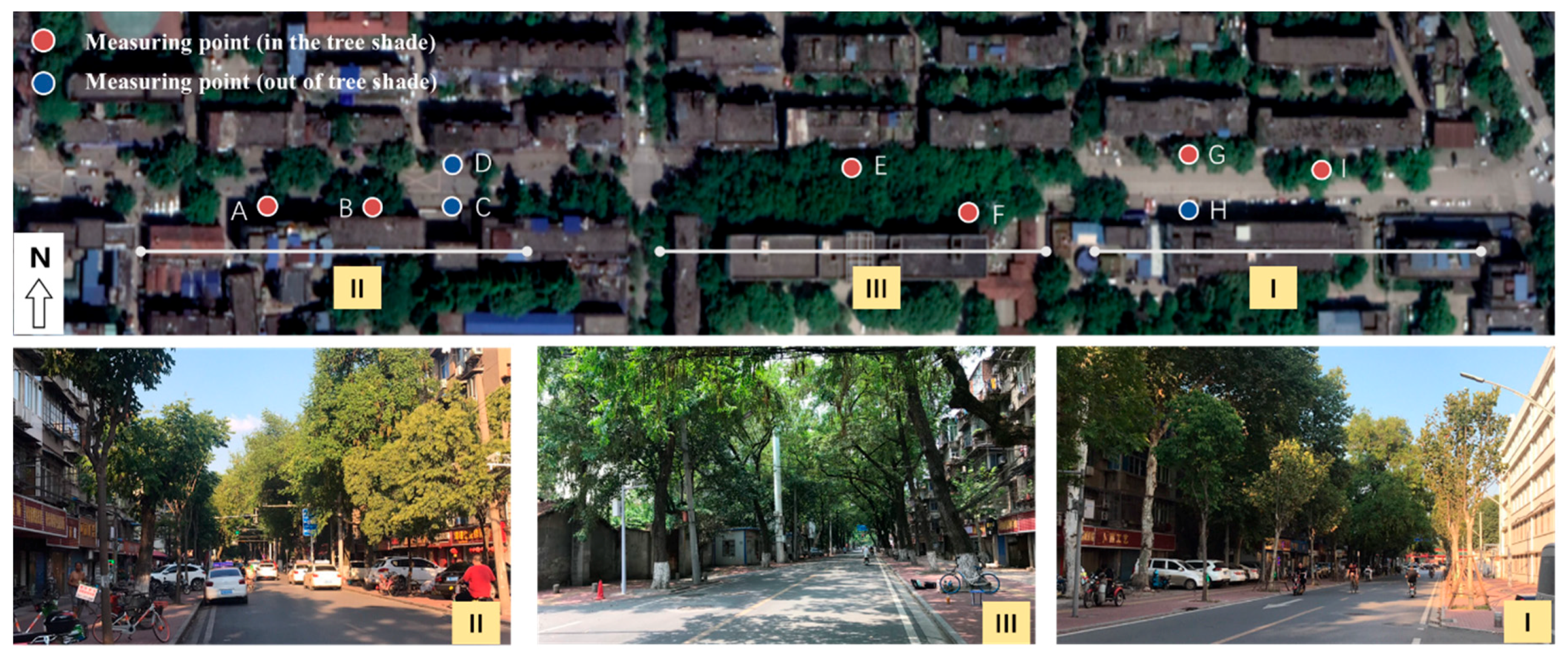

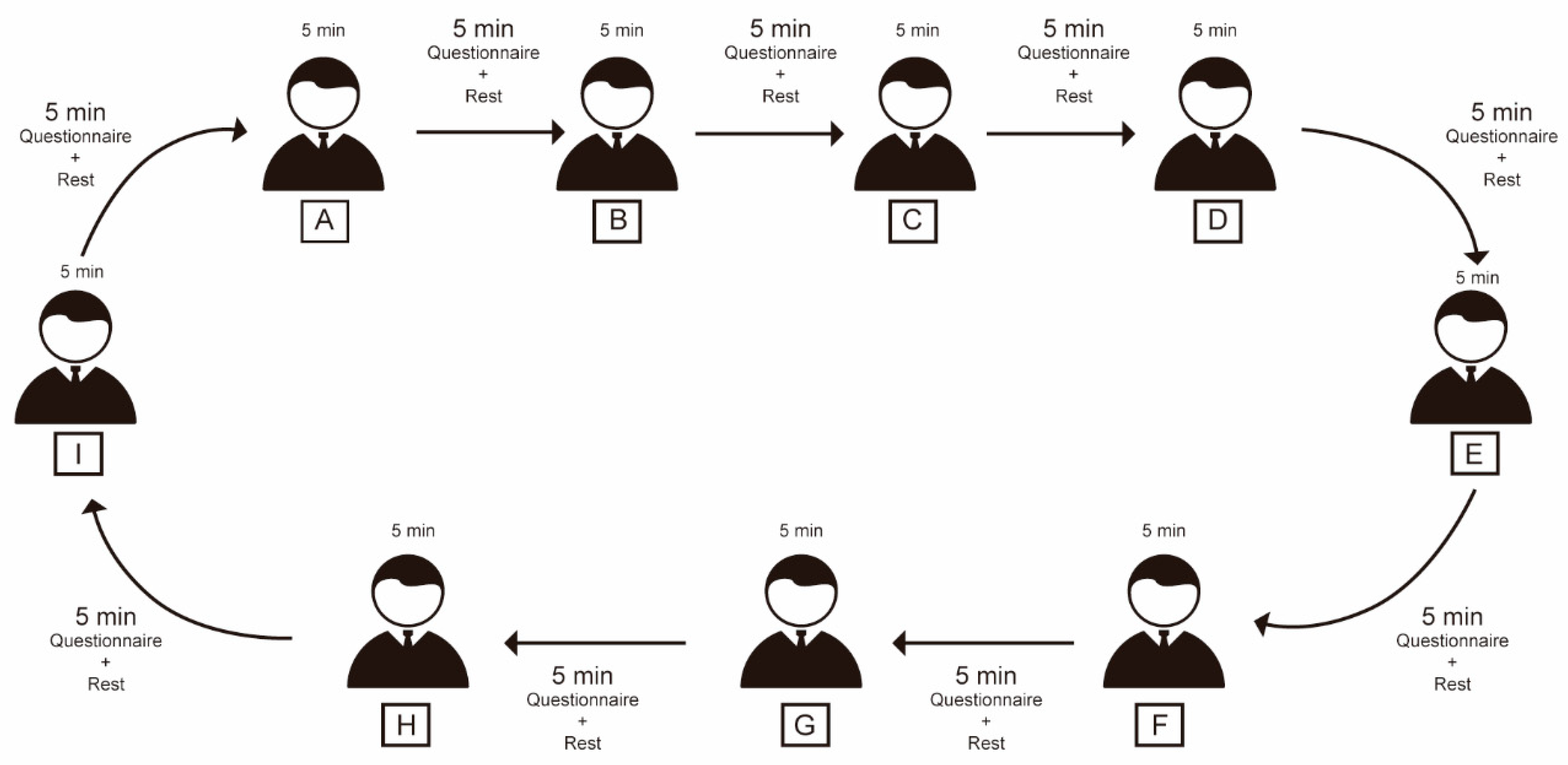
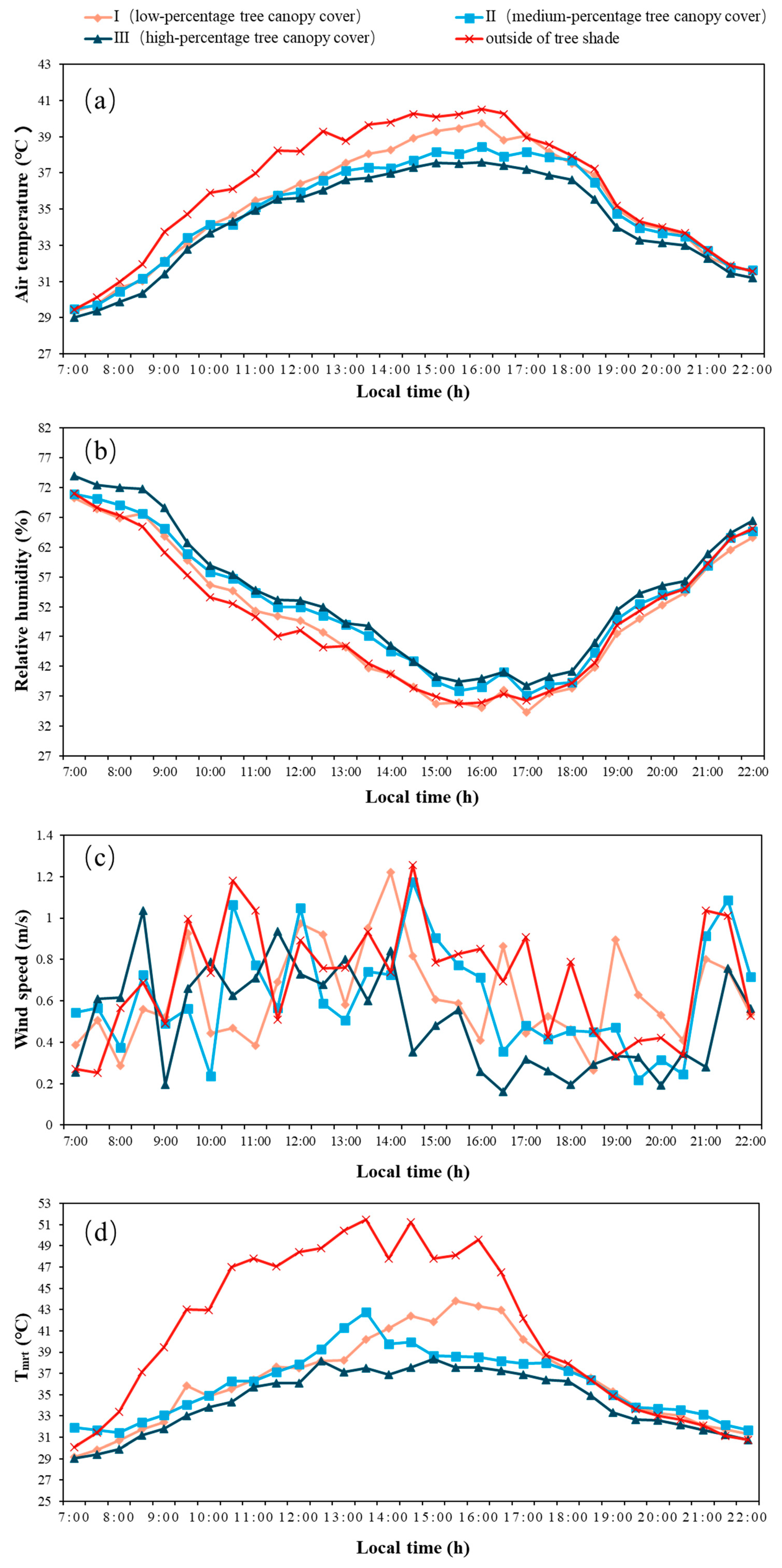
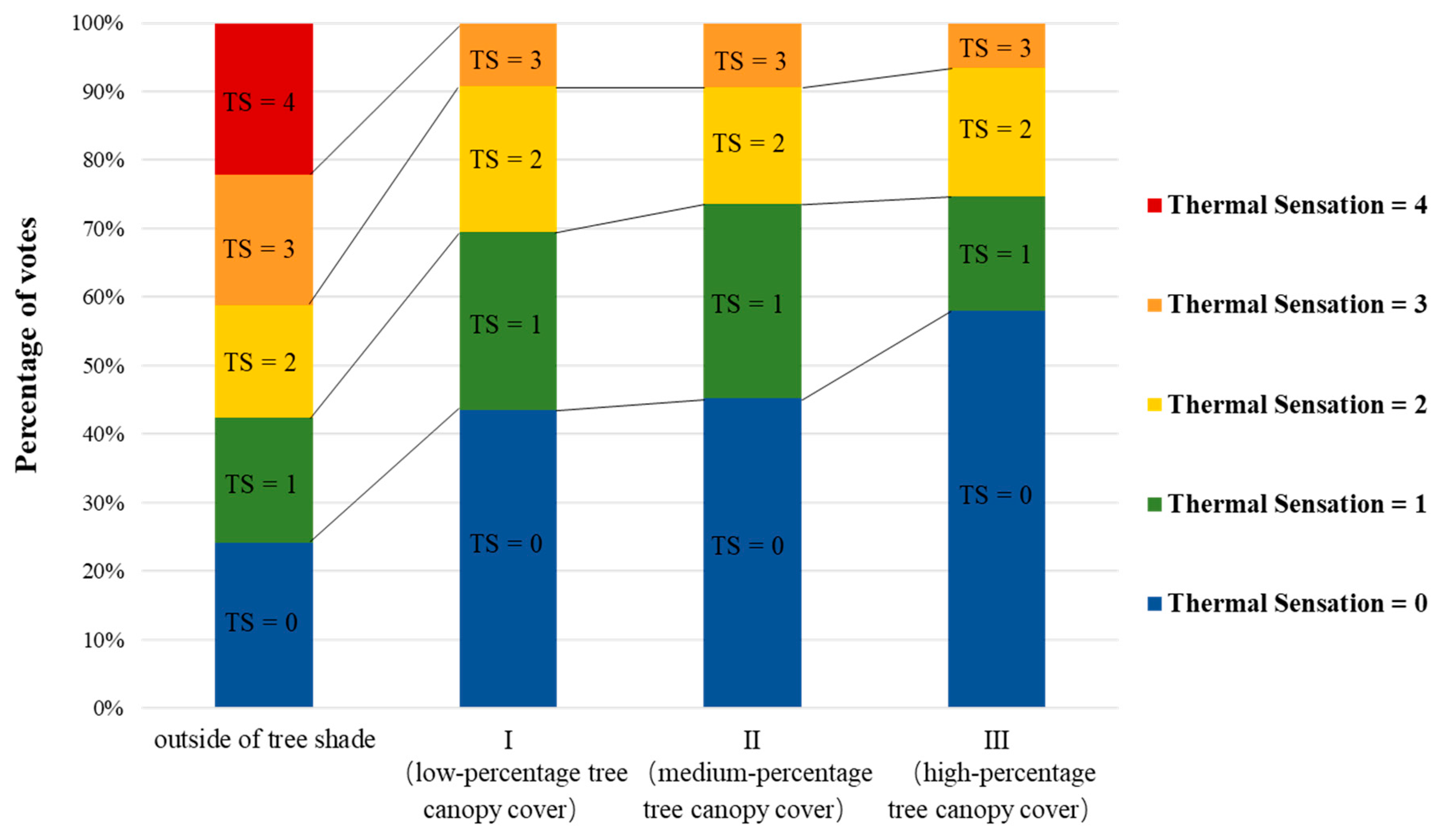
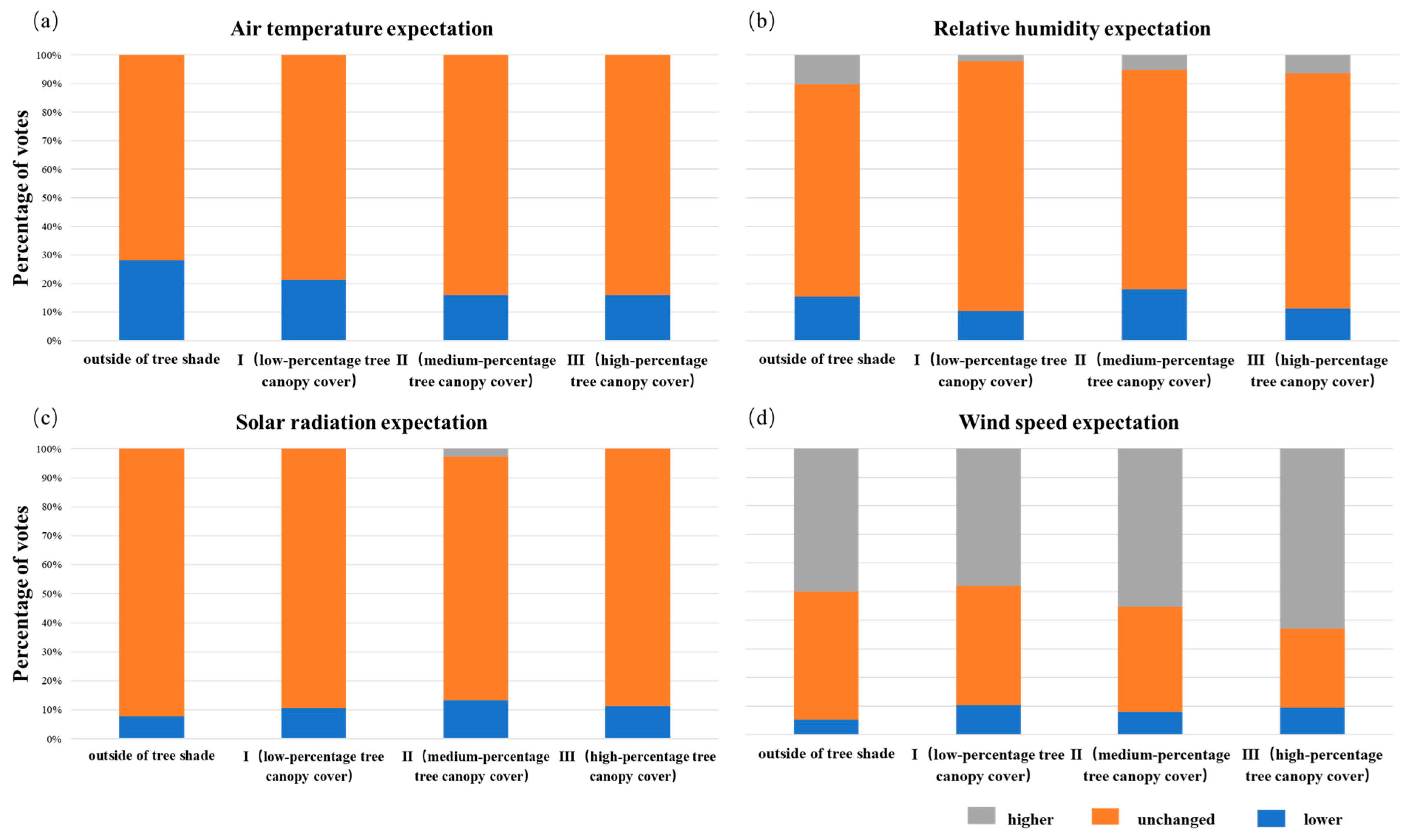
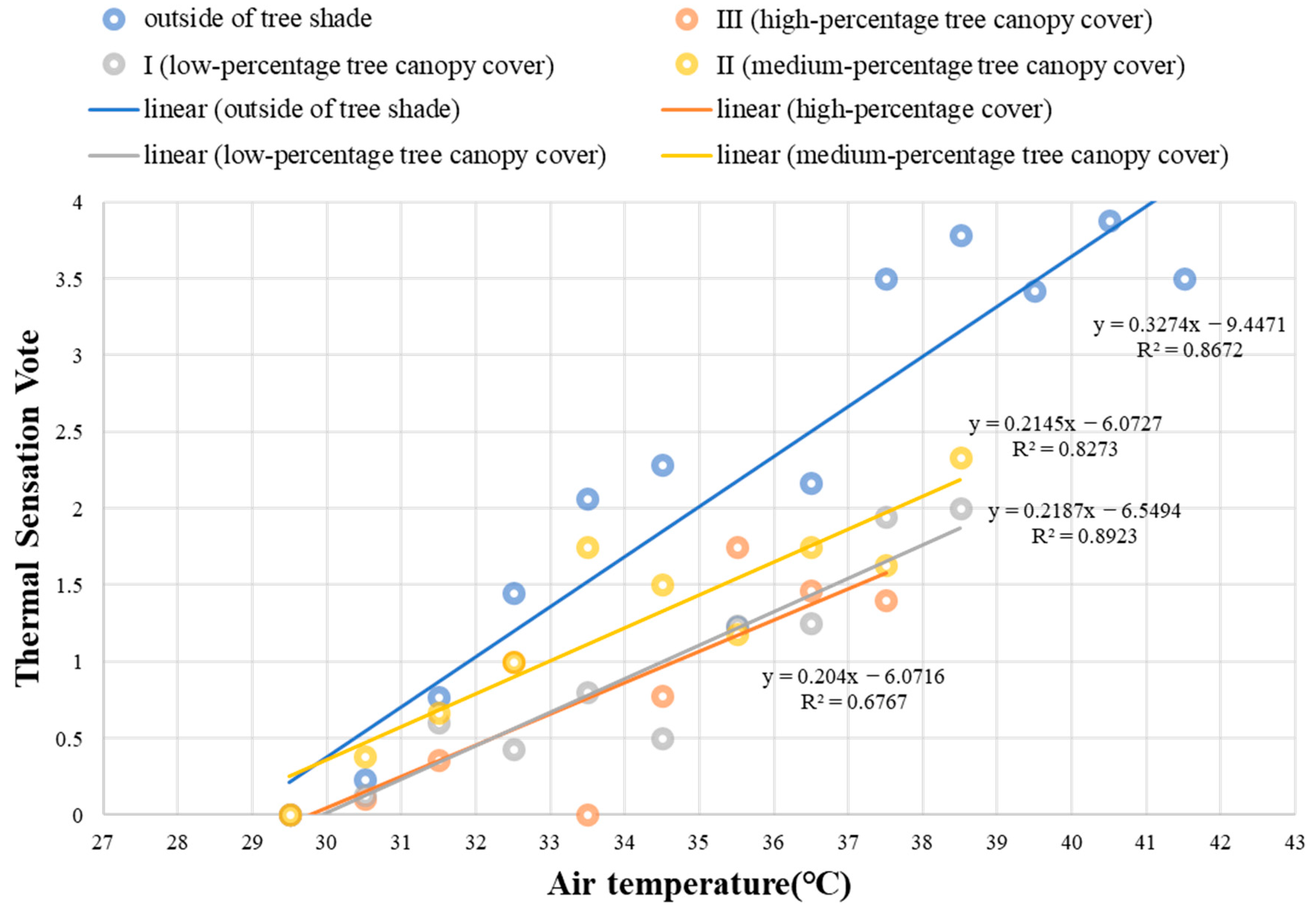
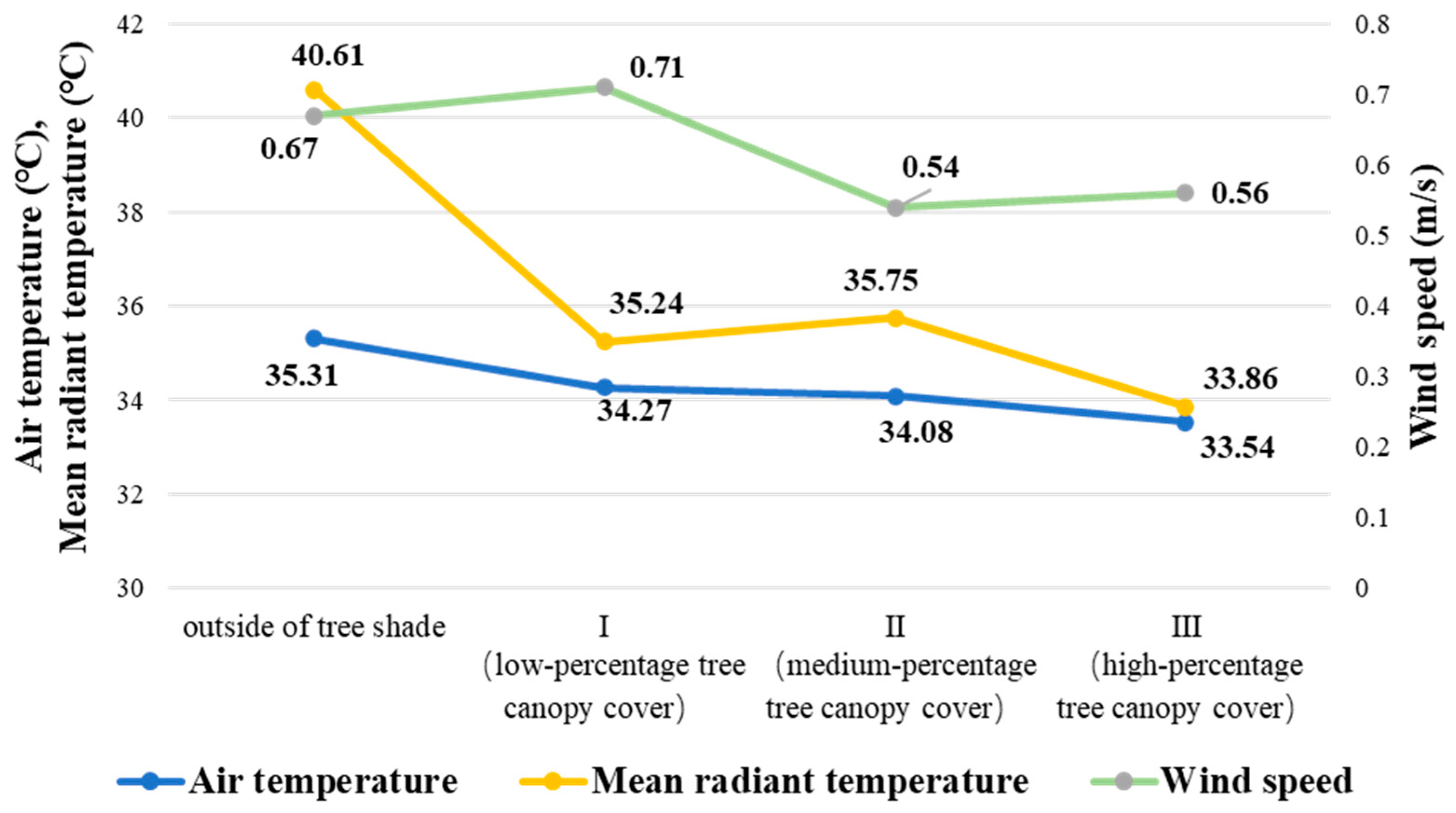
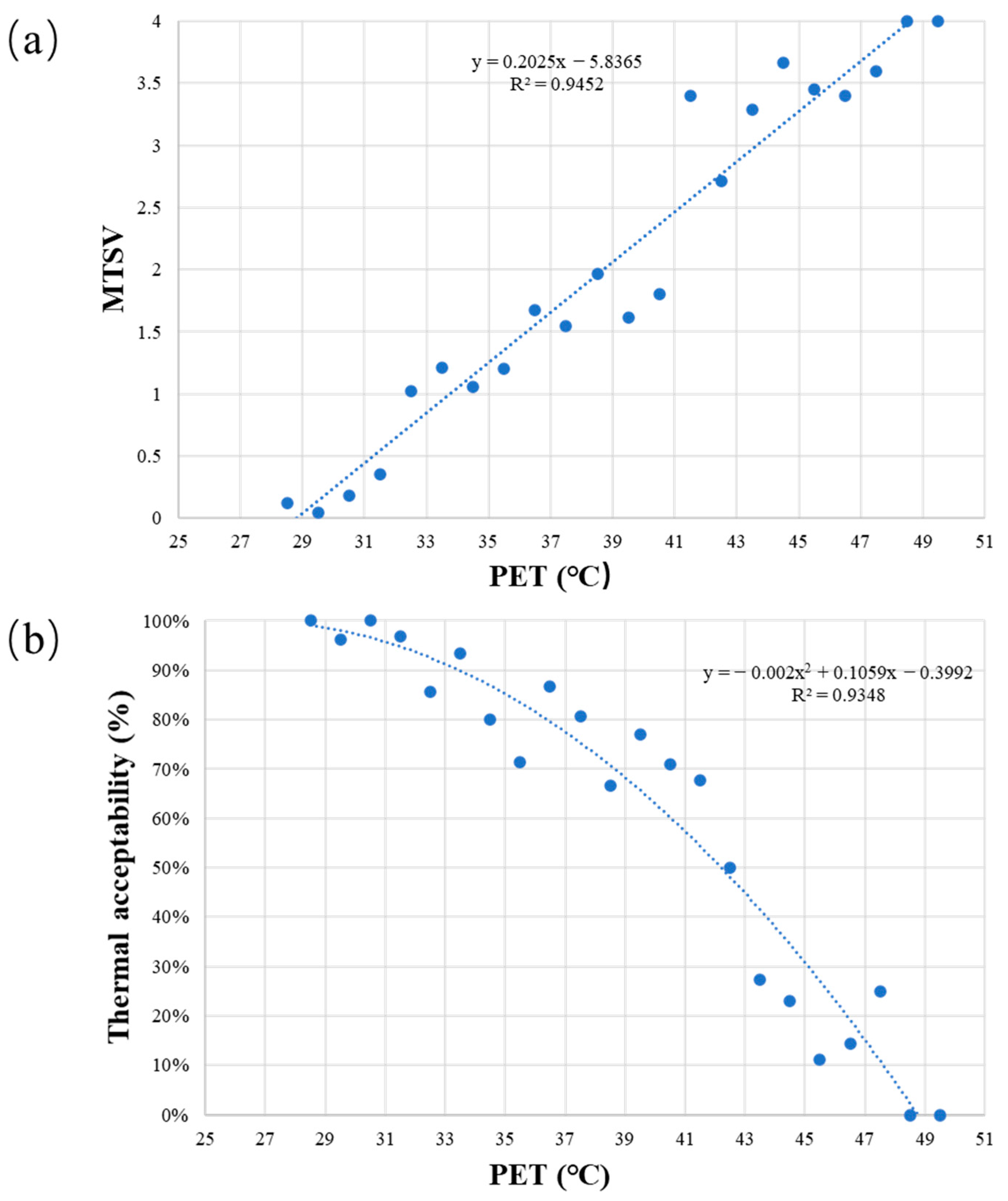
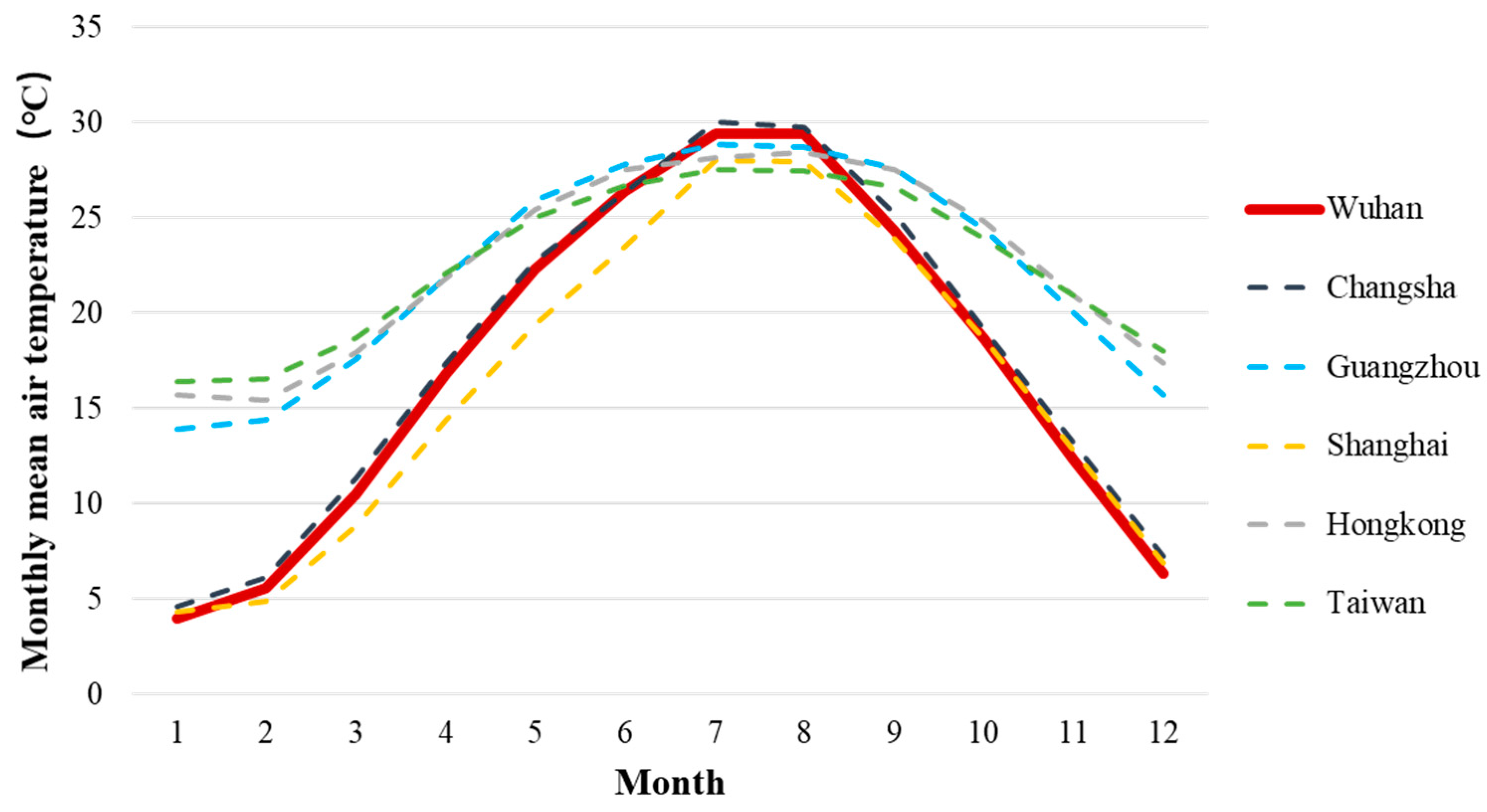
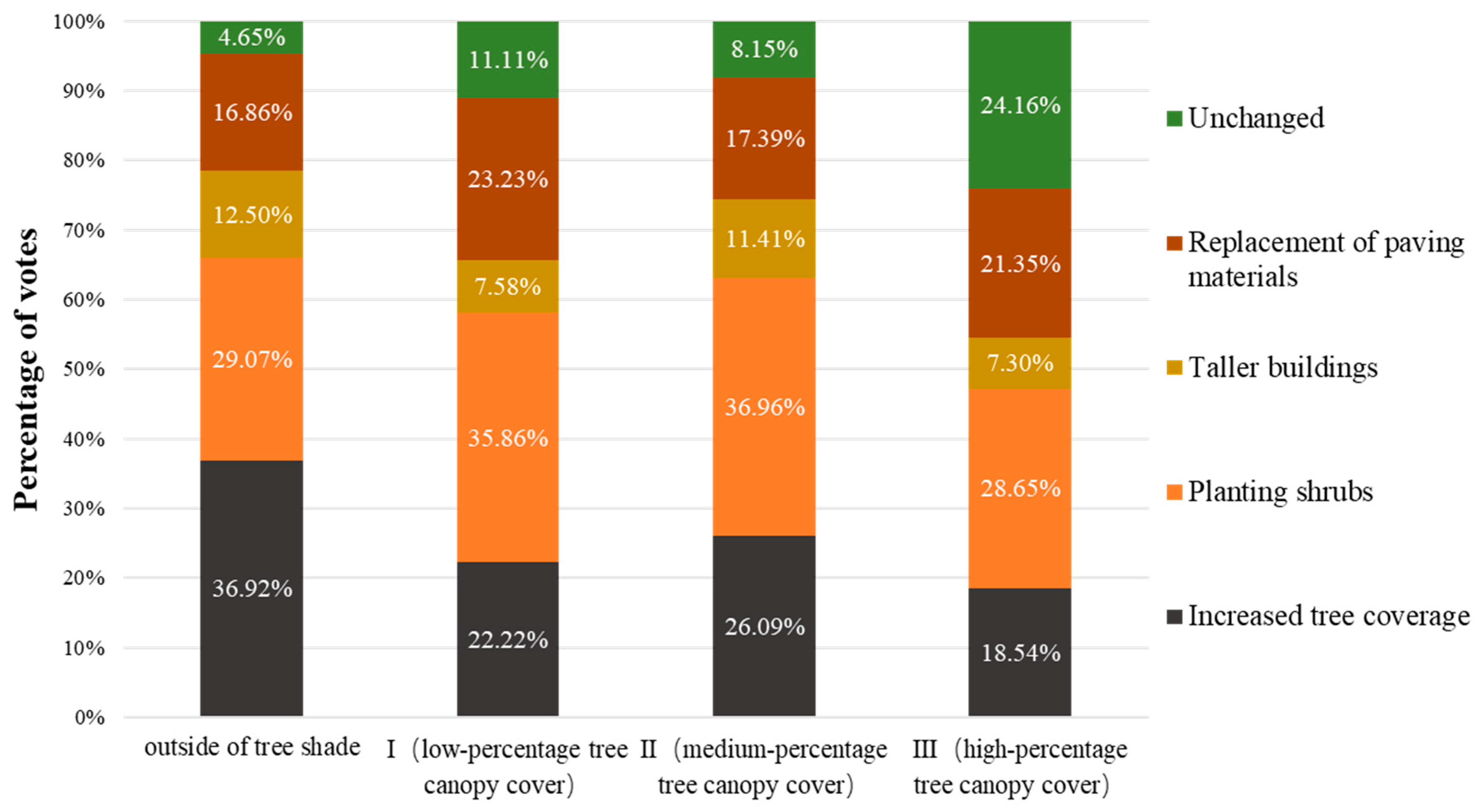
| Section Number | Tree Canopy Cover Percentage | H/W Ratio | Length | Measuring Point (in the Tree Shade) | Measuring Point (out of Tree Shade) |
|---|---|---|---|---|---|
| I | 38.61% (low percentage) | 0.62 | 150 m | G/I | H |
| II | 52.05% (medium percentage) | 0.57 | A/B | C/D | |
| III | 94.16% (high percentage) | 0.61 | E/F | – |
| Parameter | Instrument/Sensor | Specification (Accuracy) |
|---|---|---|
| Air temperature | Richter thermal comfort test system ISO7730 | ±0.5 °C |
| Relative humidity | ±2% | |
| Globe temperature | ±0.5 °C | |
| Wind speed | 0–0.5 m/s: ±5 cm; 0.5–1.5 m/s: ±10 cm; >1.5 m/s: 4% |
| Date | Air Temperature (°C) | Relative Humidity (%) | Wind Speed (m/s) | Sunrise Time | Sunset Time | ||||||
|---|---|---|---|---|---|---|---|---|---|---|---|
| Mean | Max | Min | Mean | Max | Min | Mean | Max | Min | |||
| 18 August 2019 | 32.9 | 38.2 | 28.1 | 60.8 | 88 | 39 | 1.4 | 2.6 | 0 | 5:50:54 | 19:02:33 |
| 19 August 2019 | 31.6 | 37.9 | 24.9 | 57.3 | 86 | 34 | 1.5 | 2.7 | 0.4 | 5:51:30 | 19:01:30 |
| Reference | City | Climate Zone | Study Area | Research Type | Neutral PET (°C) | PET Comfort Range (°C) |
|---|---|---|---|---|---|---|
| The present study | Wuhan | Warm and temperate (Cfa) | Street | Longitudinal | 28.82 | 26.35–31.29 |
| Yang et al., 2013 [48] | Changsha | Warm and temperate (Cfa) | Park/square/street/university campus | Horizontal | 27.92 | 24–31 |
| Li et al., 2016 [22] | Guangzhou | Warm and temperate (Cfa) | Residential area | Horizontal | – | 18.1–31.1 |
| Chen et al., 2015 [49] | Shanghai | Warm and temperate (Cfa) | Square | Horizontal | – | 15–29 |
| Cheng et al., 2012 [26] | Hongkong | Humid subtropical (Cwa) | Square | Longitudinal | 25.03 | ≤28.67 |
| Lin and Matzarakis, 2008 [50] | Sun Moon Lake, Taiwan | Humid subtropical (Cwa) | Park | Horizontal | 27.2 | 26–30 |
© 2020 by the authors. Licensee MDPI, Basel, Switzerland. This article is an open access article distributed under the terms and conditions of the Creative Commons Attribution (CC BY) license (http://creativecommons.org/licenses/by/4.0/).
Share and Cite
Huang, Z.; Wu, C.; Teng, M.; Lin, Y. Impacts of Tree Canopy Cover on Microclimate and Human Thermal Comfort in a Shallow Street Canyon in Wuhan, China. Atmosphere 2020, 11, 588. https://doi.org/10.3390/atmos11060588
Huang Z, Wu C, Teng M, Lin Y. Impacts of Tree Canopy Cover on Microclimate and Human Thermal Comfort in a Shallow Street Canyon in Wuhan, China. Atmosphere. 2020; 11(6):588. https://doi.org/10.3390/atmos11060588
Chicago/Turabian StyleHuang, Zhuodi, Changguang Wu, Mingjun Teng, and Yaoyu Lin. 2020. "Impacts of Tree Canopy Cover on Microclimate and Human Thermal Comfort in a Shallow Street Canyon in Wuhan, China" Atmosphere 11, no. 6: 588. https://doi.org/10.3390/atmos11060588
APA StyleHuang, Z., Wu, C., Teng, M., & Lin, Y. (2020). Impacts of Tree Canopy Cover on Microclimate and Human Thermal Comfort in a Shallow Street Canyon in Wuhan, China. Atmosphere, 11(6), 588. https://doi.org/10.3390/atmos11060588





